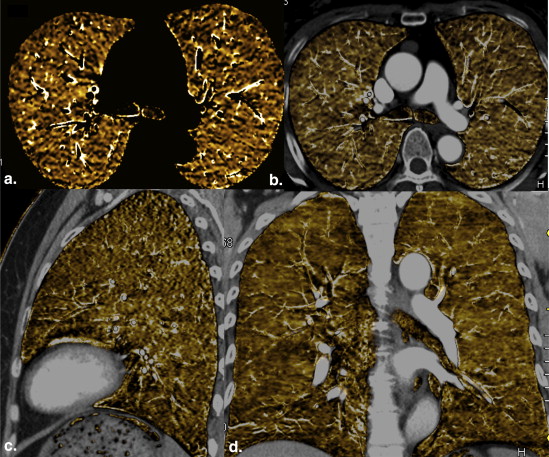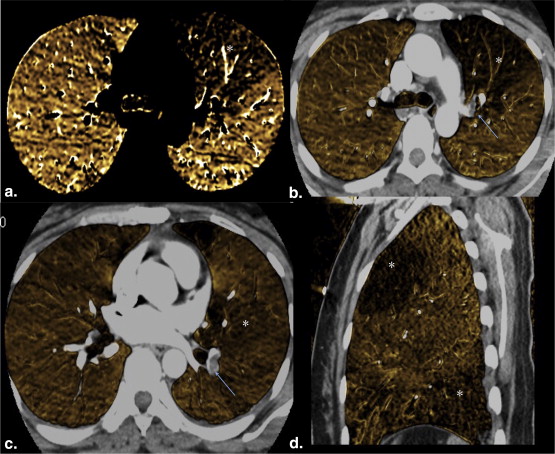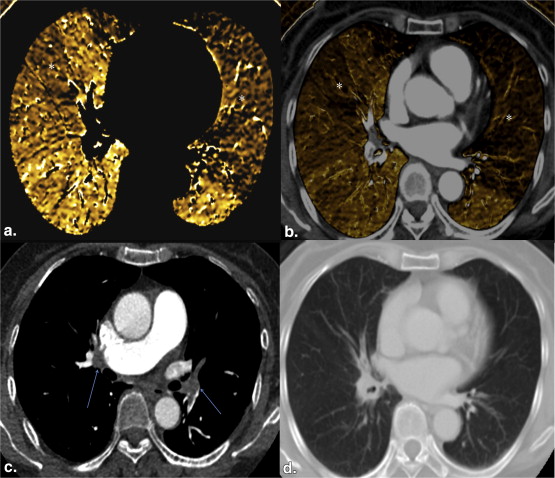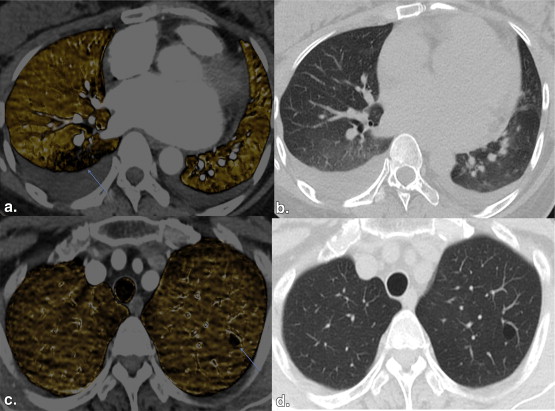Rationale and Objectives
To assess the diagnostic value of dual-energy (DE) computed tomography pulmonary angiography (CTPA) for acute pulmonary embolism (PE) using a helical DE scan mode with rapid kVp switching.
Materials and Methods
Seventy-six patients with suspected acute PE underwent DE CTPA. Two readers independently assessed and measured the iodine maps. CTPA images were assessed for the presence, location, and degree of PE as the standard of reference. Iodine maps were used to identify the perfusion defect (PD), and the diagnostic accuracy of iodine maps was calculated. The iodine concentrations of PDs and normal lung parenchyma were also measured and compared.
Results
A per-patient analysis showed the 84.6% sensitivity and 96.0% specificity of iodine map for PE, and on per-segment analysis, the sensitivity and specificity for PE were 82.9% and 99.6%, respectively. Intraobserver and interobserver variability correlations were excellent, with k values from 0.806 to 1.000. Quantitative analysis showed there was a significant difference for iodine concentration between circumscribed/patchy PDs or wedge-shaped PDs consistent with PE and normal lung parenchyma ( P < .05). The intraobserver reliability of reader 1 was from 0.928 to 0.997, and reader 2 was from 0.912 to 0.995. And, the interobserver reliability between two readers was from 0.967 to 0.999.
Conclusions
CTPA based on DE scanning with rapid kVp switching can provide both morphologic analysis and quantitative evaluation of PD related to acute PE in addition to standard CTPA data. Quantification of iodine concentration may be helpful for identifying the presence or absence of PE.
Acute pulmonary embolism (PE) is the third most common acute cardiovascular disease after myocardial infarction and stroke and can result in very high morbidity and mortality without early diagnosis and appropriate treatment . However, because clinical symptoms, physical examination findings, and laboratory tests are often nonpathognomonic, imaging examination plays an important role in the accurate diagnosis of PE. With the advent of multidetector scanning, computed tomography pulmonary angiography (CTPA) has improved dramatically with respect to image acquisition speed, total scan time, and spatial resolution. Modern CTPA techniques can provide direct visualization of emboli within the pulmonary arteries. Hence, it has become the method of choice for the evaluation of patients with a suspected PE over digital subtraction angiography (DSA) and pulmonary ventilation/perfusion (V/Q) scintigraphy .
Dual-energy (DE) CT (DECT) imaging is a novel approach to mapping the iodine distribution within lung parenchyma at a single time point and demonstrating the pulmonary perfusion . Compared with conventional CTPA, CTPA based on DE imaging not only displays the emboli and related morphologic information but also simultaneously provides function information associated with pulmonary perfusion on the iodine maps. Dual-source CT with two separate detectors has been introduced to assess the endoluminal emboli and lung perfusion for PE in some previous studies . However, they mainly focused on the morphologic analysis of iodine distribution maps. Furthermore, the limited (26 or 33 cm) field of view (FOV) of second detector available in image analysis prevented evaluation of the whole lung in some patients. A single-source CT with rapid kilovoltage switching is another promising DE scanning mode, which ensuring good temporal registration between high- and low-energy data sets and obtaining the full 50-cm FOV for use in image analysis . As a consequence, it permits a complete assessment of the bilateral pulmonary parenchyma, including the peripheral segments. A few studies have demonstrated that DECT system with fast kilovoltage switching is feasible, and quantification of iodine density may be useful to assess the severity of PE with gemstone spectral CT imaging (GSI) . To our knowledge, there are few reports regarding the evaluation of iodine concentrations in the pulmonary parenchyma using DE mode based on 320-detector row CT with rapid kVp switching.
Get Radiology Tree app to read full this article<
Materials and methods
Ethics Statement
Get Radiology Tree app to read full this article<
Patient Population
Get Radiology Tree app to read full this article<
CT Acquisition Protocol
Get Radiology Tree app to read full this article<
Get Radiology Tree app to read full this article<
Get Radiology Tree app to read full this article<
Data Analysis
Get Radiology Tree app to read full this article<
Get Radiology Tree app to read full this article<
Get Radiology Tree app to read full this article<
Statistical Analysis
Get Radiology Tree app to read full this article<
Get Radiology Tree app to read full this article<
Results
Dose Measurement
Get Radiology Tree app to read full this article<
Diagnosis of Acute PE
Get Radiology Tree app to read full this article<
Get Radiology Tree app to read full this article<
Get Radiology Tree app to read full this article<
Get Radiology Tree app to read full this article<
Get Radiology Tree app to read full this article<
Table 1
The Diagnostic Sensitivity and Specificity of Readers 1 and 2 for the Detection of PDs Consist With PE
Reader Per-Patient Analysis Per-Segment Analysis Sensitivity Specificity Sensitivity Specificity Reader 1 (%) First 84.6 (22/26; 77.5–91.7) 92.0 (46/50; 88.2–95.8) 80.6 (112/139; 77.2–84.0) 98.4 (1284/1305; 98.1–98.7) Second 84.6 (22/26; 77.5–91.7) 92.0 (46/50; 88.2–95.8) 81.5 (110/135; 78.2–84.8) 98.1 (1284/1309; 97.7–98.5) Intraobserver 1.000 0.908 Reader 2 (%) First 80.8 (21/26; 65.7–95.9) 90.0 (45/50; .85.8–94.2) 78.3 (108/138; 74.8–81.8) 97.5 (1274/1306; 97.1–97.9) Second 80.8 (21/26; 65.7–95.9) 90.0 (45/50; 85.8–94.2) 77.8 (105/135; 74.2–81.4) 97.3 (1274/1309; 96.9–97.7) Intraobserver 1.000 0.907 Interobserver 0.866 0.806
PD, perfusion defect; PE, pulmonary embolism.
Get Radiology Tree app to read full this article<
Get Radiology Tree app to read full this article<
Get Radiology Tree app to read full this article<
Quantitative Measurement of Iodine Map
Get Radiology Tree app to read full this article<
Table 2
Measurements of Iodine Concentrations (Hounsfield Unit) of Wedge-Shaped or Circumscribed/Patchy PD and Corresponding Normal Lung on the Other Side From Two Readers
Reader Iodine Concentration Iodine Concentration Wedge-Shaped PD Normal Lung_P_ Value Circumscribed/Patchy PD Normal Lung_P_ Value Reader 1 First 11.87 ± 7.25 36.58 ± 13.49 .000 10.60 ± 4.53 38.44 ± 13.27 .001 Second 12.18 ± 7.77 34.95 ± 10.78 .000 12.77 ± 6.14 41.64 ± 12.52 .000 Reader 2 First 11.54 ± 7.19 38.34 ± 11.55 .000 12.36 ± 8.95 36.13 ± 12.72 .000 Second 13.15 ± 8.17 37.54 ± 11.62 .000 11.79 ± 6.26 39.45 ± 11.84 .000
PD, perfusion defect.
Get Radiology Tree app to read full this article<
Get Radiology Tree app to read full this article<
Table 3
Measurements of Iodine Concentrations (Hounsfield Unit) of Ventral and Dorsal Part of Normal Lung From Two Readers
Reader Right Lung Left Lung Ventral Part Dorsal Part_P_ Value Ventral Part Dorsal Part_P_ Value Reader 1 First 23.58 ± 7.56 36.97 ± 13.13 .000 23.64 ± 9.31 38.85 ± 15.24 .000 Second 27.00 ± 8.49 41.05 ± 14.42 .000 27.38 ± 8.90 43.30 ± 13.62 .000 Reader 2 First 22.16 ± 6.91 37.59 ± 13.51 .000 21.76 ± 8.05 38.94 ± 13.57 .000 Second 25.86 ± 8.22 39.86 ± 12.71 .000 24.21 ± 8.33 40.32 ± 12.26 .000
Get Radiology Tree app to read full this article<
Get Radiology Tree app to read full this article<
Table 4
Intraobserver and Interobserver Variability of the Iodine Concentration Measurements for Each Reader Based on ICC (95% Confidence Interval)
Measurement Intraobserver Interobserver Reader 1 Reader 2 Wedge-shaped PD 0.954 (0.913–0.976) 0.957 (0.919–0.977) 0.993 (0.986–0.996) Normal lung on the other side 0.987 (0.975–0.993) 0.993 (0.986–0.996) 0.997 (0.994–0.998) Circumscribed/patchy PD 0.928 (0.834–0.970) 0.912 (0.800–0.963) 0.992 (0.982–0.997) Normal lung on the other side 0.997 (0.992–0.999) 0.995 (0.988–0.998) 0.999 (0.997–1.000) Left lung, ventral part 0.980 (0.956–0.991) 0.969 (0.933–0.986) 0.998 (0.996–0.999) Left lung, dorsal part 0.957 (0.908–0.980) 0.935 (0.862–0.970) 0.993 (0.985–0.997) Right lung, ventral part 0.939 (0.869–0.972) 0.932 (0.855–0.969) 0.995 (0.989–0.998) Right lung, dorsal part 0.933 (0.882–0.951) 0.972 (0.958–0.987) 0.967 (0.929–0.985)
ICC, intraclass and interclass correlation coefficient; PD, perfusion defect.
Get Radiology Tree app to read full this article<
Discussion
Get Radiology Tree app to read full this article<
Get Radiology Tree app to read full this article<
Get Radiology Tree app to read full this article<
Get Radiology Tree app to read full this article<
Get Radiology Tree app to read full this article<
Get Radiology Tree app to read full this article<
Get Radiology Tree app to read full this article<
Acknowledgments
Get Radiology Tree app to read full this article<
Get Radiology Tree app to read full this article<
Get Radiology Tree app to read full this article<
References
1. Kurcz J., Garcarek J., Guziński M., et. al.: Multislice computed tomography angiography as an imaging modality of choice in patients with suspicion of pulmonary embolism - own experiences and modern imaging techniques. Adv Clin Exp Med 2013; 22: pp. 705-713.
2. Kincl V., Feitova V., Panovsky R., et. al.: Assessment of the severity of acute pulmonary embolism using CT pulmonary angiography parameters. Biomed Pap Med Fac Univ Palacky Olomouc Czech Repub 2013; [Epub ahead of print]
3. Cheng J., Yin Y., Wu H., et. al.: Optimal monochromatic energy levels in spectral CT pulmonary angiography for the evaluation of pulmonary embolism. PLoS One 2013; 8: pp. e63140.
4. Thieme S.F., Johnson T.R., Reiser M.F., et. al.: Dual-energy lung perfusion computed tomography: a novel pulmonary functional imaging method. Semin Ultrasound CT MR 2010; 31: pp. 301-308.
5. Kaza R.K., Platt J.F., Cohan R.H., et. al.: Dual-energy CT with single- and dual-source scanners: current applications in evaluating the genitourinary tract. Radiographics 2012; 32: pp. 353-369.
6. Geyer L.L., Scherr M., Körner M., et. al.: Imaging of acute pulmonary embolism using a dual energy CT system with rapid kVp switching: initial results. Eur J Radiol 2012; 81: pp. 3711-3718.
7. Hansmann J., Apfaltrer P., Zoellner F.G., et. al.: Correlation analysis of dual-energy CT iodine maps with quantitative pulmonary perfusion MRI. World J Radiol 2013; 5: pp. 202-207.
8. Thieme S.F., Johnson T.R., Lee C., et. al.: Dual-energy CT for the assessment of contrast material distribution in the pulmonary parenchyma. AJR Am J Roentgenol 2009; 193: pp. 144-149.
9. Ferda J., Ferdová E., Mírka H., et. al.: Pulmonary imaging using dual-energy CT, a role of the assessment of iodine and air distribution. Eur J Radiol 2011; 77: pp. 287-293.
10. Hong Y.J., Kim J.Y., Choe K.O., et. al.: Different perfusion pattern between acute and chronic pulmonary thromboembolism: evaluation with two-phase dual-energy perfusion CT. AJR Am J Roentgenol 2013; 200: pp. 812-817.
11. Bauer R.W., Kerl J.M., Weber E., et. al.: Lung perfusion analysis with dual energy CT in patients with suspected pulmonary embolism—influence of window settings on the diagnosis of underlying pathologies of perfusion defects. Eur J Radiol 2011; 80: pp. e476-e482.
12. Zhang L.J., Zhou C.S., Schoepf U.J., et. al.: Dual-energy CT lung ventilation/perfusion imaging for diagnosing pulmonary embolism. Eur Radiol 2013; 23: pp. 2666-2675.
13. Wu H.W., Cheng J.J., Li J.Y., et. al.: Pulmonary embolism detection and characterization through quantitative iodine-based material decomposition images with spectral computed tomography imaging. Invest Radiol 2012; 47: pp. 85-91.
14. Thieme S.F., Becker C.R., Hacker M., et. al.: Dual energy CT for the assessment of lung perfusion—correlation to scintigraphy. Eur J Radiol 2008; 68: pp. 369-374.
15. Chai X., Zhang L.J., Yeh B.M., et. al.: Acute and subacute dual energy CT findings of pulmonary embolism in rabbits: correlation with histopathology. Br J Radiol 2012; 85: pp. 613-622.
16. Zhang L.J., Zhao Y.E., Wu S.Y., et. al.: Pulmonary embolism detection with dual-energy CT: experimental study of dual-source CT in rabbits. Radiology 2009; 252: pp. 61-70.
17. Tang C.X., Zhang L.J., Han Z.H., et. al.: Dual-energy CT based vascular iodine analysis improves sensitivity for peripheral pulmonary artery thrombus detection: an experimental study in canines. Eur J Radiol 2013; 82: pp. 2270-2278.
18. Pontana F., Faivre J.B., Remy-Jardin M., et. al.: Lung perfusion with dual-energy multidetector-row CT (MDCT): feasibility for the evaluation of acute pulmonary embolism in 117 consecutive patients. Acad Radiol 2008; 15: pp. 1494-1504.
19. Thieme S.F., Graute V., Nikolaou K., et. al.: Dual energy CT lung perfusion imaging—correlation with SPECT/CT. Eur J Radiol 2012; 81: pp. 360-365.
20. Wildberger J.E., Niethammer M.U., Klotz E., et. al.: Multi-slice CT for visualization of pulmonary embolism using perfusion weighted color maps. Rofo 2001; 173: pp. 289-294.
21. Kerl J.M., Bauer R.W., Renker M., et. al.: Triphasic contrast injection improves evaluation of dual energy lung perfusion in pulmonary CT angiography. Eur J Radiol 2011; 80: pp. e483-e487.
22. Hoey E.T., Gopalan D., Ganesh V., et. al.: Dual-energy CT pulmonary angiography: a novel technique for assessing acute and chronic pulmonary thromboembolism. Clin Radiol 2009; 64: pp. 414-419.



